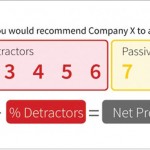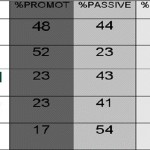Going beyond Customer Satisfaction with Net Promoter Score
Customer satisfaction is no longer the ultimate goal of companies in their relationship with clients. Going beyond the satisfaction level, % Net promoter score outlines how many of your clients would recommend you products and services.
Bain & Company studies show that companies that have achieved long-term profitable growth have Net Promoter Scores (NPS) scores two times higher than the average company. This KPI enables organizations to see the link between the quality of customer relationships and its growth prospects.
NPS splits the customers into 3 clusters:- “Promoters” – are considered loyal clients that will keep on buying the company’s products and services and will recommend to other people to do the same.
- “Passives” – are satisfied clients, but would not recommend the company and can easily be won by competitor products and services.
- “Detractors” – are unsatisfied customers, who most certainly would not recommend the company.
One of the challenges in measuring this KPI is to distinguish between the customer’s satisfaction with one service, like Customer Care and his loyalty to the company, or brand. This is why companies usually use both bottom-up and top-down surveys.
According to Bain & Company, top-down surveys are designed to show a company’s relative performance and identify aggregate patterns rather than to generate diagnostic insights for individual customers. The respondent usually does not know who is sponsoring the survey and the company cannot track back responses to get to the individual respondent. Typical questions include:
- Questions to qualify the respondent as a customer
- Likelihood-to-recommend question
- Open-ended request for further explanation
- Additional question(s) on other aspects of the product, service or brand
- Optionally: information about the customer’s purchases, usage and referral behavior that enable analysis of differences in financial outcomes
- Any final questions that can help with customer segmentation
Bottom-up surveys are sponsored by the company and usually take place after a transaction. They consist in just three questions:
- Likelihood-to-recommend question
- Open-ended request for further explanation
- Permission to follow-up
Bain & Company studies reflect that the most common positive score for NPS is between 5% and 10%, while some industries have negative scores. This is an important indicator, as it outlines that the company is generating detractors through its relationship with customers. In this case, as serious analysis should be done in order to identify what is stopping customers from being satisfied and promote the product: Is it the quality of the product? The service delivery?
Performant and customer-oriented companies, like Amazon, Rackspace, TD Bank, Zappos, Costco and Dell have a NPS score between 50% and 80%.
The major advantage of NPS is its simplicity, but in the same time it has been criticized for the same aspect. Just one question or two questions do not provide as much data to support strategies and decision making comparing to a full customer survey. Despite this, NPS is considered to be more relevant than satisfaction levels in assessing the value added by customer relationships.
References:
- Smartkpis.com (2013), Net Promoter Score
- Bain & Company (2013), Measuring your Net Promoter Score
- SurveyMonkey.com (2013), The Net Promoter Score
Image source:

Tags: Customer Satisfaction, KPI, Net Promoter Score






